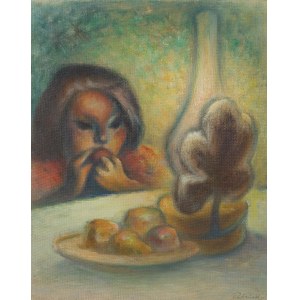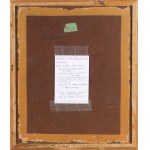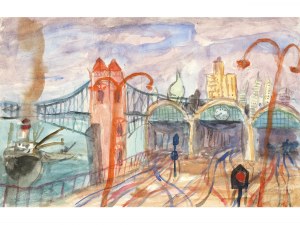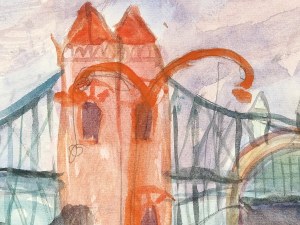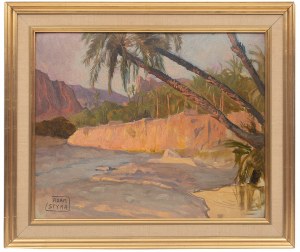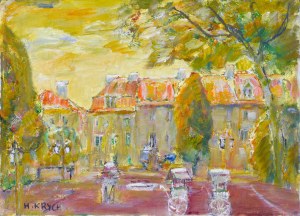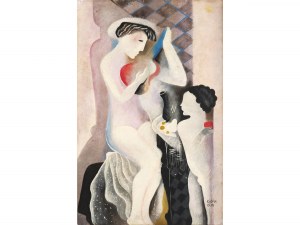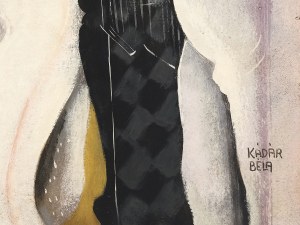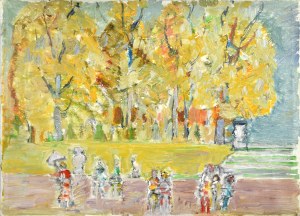THEODOR FRIED*
(Budapest 1902 - 1980 New York)
Dessert, 1948
oil/fiber board, 59,5 x 50,5 cm
signed Th. Fried and dated 1948
verso signed Th. Fried, 400 W., 23 St., New York II, N.Y., titled and dated "Dessert" 1948
Provenance: private collection Vienna
ESTIMATE °€ 1.000 - 2.000
START € 1.000
Hungarian painter of the 20th century. He came from a Jewish family. Studied at the Academy of Fine Arts in Budapest from 1920 to 1924. Member of the November Group. From 1924 in Vienna, member of the Hagenbund. 1925 to 1939 in Paris, friendship with photographer André Kertész. Spent much time at Le Dôme Café and exhibited at the Salon d'Automne. Regular contacts and exhibitions in Vienna. Member of the Hagenbund. Exhibited together with Frieda Salvendy. Emigrated to New York in 1942. Created mainly representations of supposed everyday situations and human relationships to each other. Initially influenced by Expressionism, developed in the direction of New Objectivity.
This painting with the little sweet tooth is part of a series of children's pictures by Theodor Fried, which the native Hungarian artist has been painting since the 1920s, preferably of infants in prams and nursing mothers, of children playing exuberantly and making music with concentration, or of children singing together paints with adults. In this painting, too, Fried relies on a concentration of motifs, in that in addition to the edge of the table he only needs the girl snacking and at the table only the bowl with pears and apples and a glowing kerosene lamp with a leaf-shaped reflector as props for his picture story. Our picture was taken in 1948, in the aftermath of the hunger winter of 1946/7, when Fried's European homeland was still very much aware of the shortage, in contrast to New York, the place where the picture was taken, which was consistently well supplied. Fried does not go into the interior and the possibilities of light-dark effects offered by the artificial light source. He avoids striking contours here, which makes everything seem bathed in a sfumato-like light. Born in Budapest (or possibly Szeged) in 1902, the painter was the son of a Jewish watchmaker and jeweller. Between 1920 and 1924 he studied at the Budapest Academy of Fine Arts under Gyula Rudnay, before moving to Vienna in 1924 - with seven oil paintings and sixty drawings in his luggage. In the same year he received a solo exhibition at the Hugo Heller Gallery, through which Fried soon became acquainted with the younger generation of Austrian artists associated with the Hagenbund. In addition, art critics and art historians such as Fritz Grossmann and Fritz Novotny became aware of him. Through his connection to the Heller family, he must have met his first wife, Anna Politzer, the daughter of a Viennese goldsmith, in Vienna. Although he received another exhibition in this Viennese gallery in 1925, he moved to Paris in June 1925. In his early work from this period, Fried was primarily concerned with the existential situation of people and their relationships to one another. After initially “expressive” painting and a preferred tenebrous palette, he gradually simplified the form, emphasized the contours and brightened the colors. In Paris he became a member of the École de Paris and founded a studio in Montmartre. The Antwerp writer and avant-garde painter Ferdinand Berckelaers, alias Michael Seuphor, would not only introduce him to the Parisian art scene, but also introduce him to the Hungarian photographer André Kertész, with whom Fried had a lifelong friendship. This time was overshadowed by great material worries, which is why he took on a wide variety of odd jobs - clothing design for a Parisian fashion house, employee (puppeteer) in a puppet theater and playing the violin in a cinema orchestra. Nevertheless, he maintained contacts with the Viennese art scene: in 1927 Fried participated in the exhibition "The Making of a Work of Art" at the Austrian Museum of Art and Industry, which also featured works by Ehrlich, Hanak, Jungnickel, Kokoschka, Laske and Merkel.
PLEASE NOTE:
The purchase price consists of the highest bid plus the buyer's premium, sales tax and, if applicable, the fee of artists resale rights. In the case of normal taxation (marked ° in the catalog), a premium of 24% is added to the highest bid. The mandatory sales tax of 13% is added to the sum of the highest bid and the buyer's premium. The buyer's premium amounts to 28% in case of differential taxation. The sales tax is included in the differential taxation.
Recently viewed
Please log in to see lots list
Favourites
Please log in to see lots list



